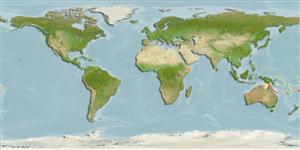>
Eupercaria/misc (Various families in series Eupercaria) >
Labridae (Wrasses) > Cheilininae
Etymology: Cirrhilabrus: Latin, cirrus = curl fringe + Greek, labros = furious (Ref. 45335); squirei: Named for Lyle Squire of Cairns Marine..
Environment: milieu / climate zone / depth range / distribution range
Ecologia
marinhas associadas(os) a recifes; intervalo de profundidade 28 - 65 m (Ref. 118208). Tropical
Western Pacific: Australia.
Tamanho / Peso / Idade
Maturity: Lm ? range ? - ? cm
Max length : 5.6 cm SL macho/indeterminado; (Ref. 118208)
Descrição suscinta
Chaves de identificação | Morfologia | Morfometria
Espinhos dorsais (total) : 11; Raios dorsais (total) : 9; Espinhos anais: 3; Raios anais : 9; Vértebras: 25. This species is distinguished by the following characters: D XI,9 (a female paratype with XII,9); A III,9; pectoral rays 15; lateral line scales 17+7; median predorsal scales 5; horizontal rows of scales on cheek 2; gill rakers 13-15; body depth 2.85-3.40 in SL, width 1.95-2.15 in body depth; head length 2.75-2.90 in SL; snout length 4.1-4.4 in HL; short pelvic fin, not reaching base of the anal fin, 4.15-4.65 in SL; rounded to truncate caudal fin in females and moderately to strongly lunate in males, caudal concavity as great as 0.8 in head; large eye, orbit diameter 3.55-3.90 in HL; colour in life with body yellow shading yellow white on abdomen, 5 irregular red orange bands, yellow dorsal fin with spinous portion having dusky spots on outer part, black on the first membrane, a central lavender band becoming black toward soft rays and soft portion with a black central band abruptly translucent posteriorly, the anal fin yellow, soft portion with a broad lavender black central band becoming narrower on the spinous part, the caudal fin yellow with 7 dusky black tongue-shaped extensions on the innermost rays; colour when preserved, males pale yellow and bands mentioned above on dorsal, anal and caudal fins are dusky to black, paired fins translucent (Ref. 118208).
Ciclo de vida ou comportamento de acasalamento
Maturities | Reprodução | Spawnings | Egg(s) | Fecundities | Larvas
Walsh, F.M., 2014. Cirrhilabrus squirei, a new wrasse (Perciformes; Labridae) from the Great Barrier Reef and Coral Sea, Australia. aqua, Int. J. Ichthyol. 20(3): 123-130. (Ref. 118208)
Status na Lista Vermelha da UICN (Ref. 130435)
Ameaça para os humanos
Harmless
Uso pelos humanos
Ferramentas
Relatórios especiais
Baixar XML
Fontes da internet
Estimates based on models
Índice de diversidade filogenética (Ref.
82804): PD
50 = 0.5000 [Uniqueness, from 0.5 = low to 2.0 = high].
Bayesian length-weight: a=0.01585 (0.00707 - 0.03555), b=2.95 (2.76 - 3.14), in cm total length, based on LWR estimates for this (Sub)family-body shape (Ref.
93245).
Nível Trófico (Ref.
69278): 3.3 ±0.4 se; based on size and trophs of closest relatives
Resiliência (Ref.
120179): Elevada, tempo mínimo de duplicação da população menor que 15 meses (Preliminary K or Fecundity.).
Fishing Vulnerability (Ref.
59153): Low vulnerability (10 of 100).
